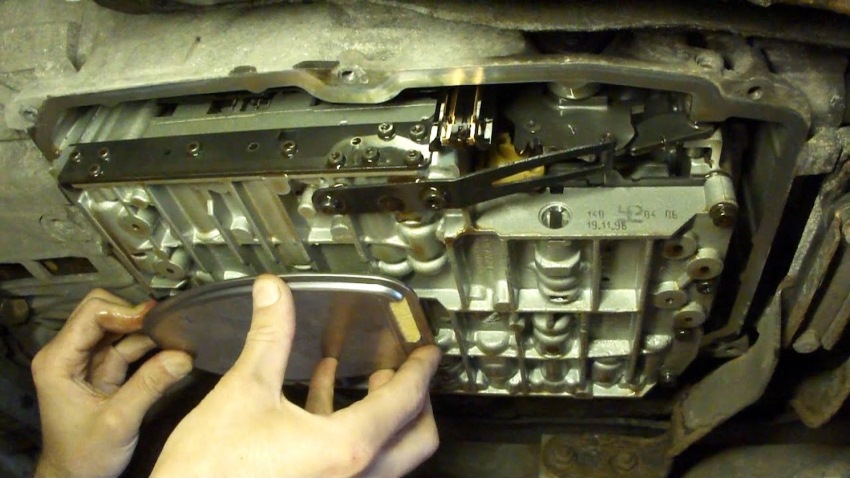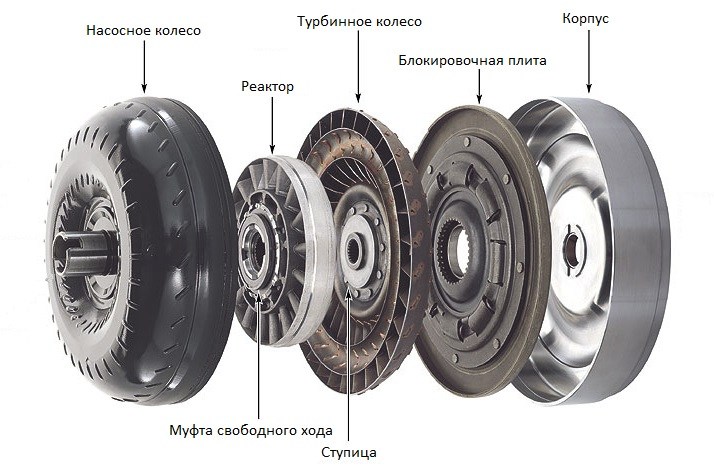
How to check the automatic transmission for serviceability
Content
The performance of an automatic transmission (automatic transmission) is one of the most important factors that determine the prospects for buying a used car. The cause of malfunctions can be not only prolonged operation, but also unprofessional repairs, incorrect oil selection and regular overloads.
Before you check the automatic transmission in dynamics, you need to ask the seller about the features of using the car and inspect the automatic transmission.
How to check the serviceability of the automatic transmission during the initial inspection

After a cursory interview with the seller and an initial inspection of the car and automatic transmission, the need for a deeper check, inspection and test drive may disappear. Even before direct contact with the owner of the vehicle, you need to pay attention to 2 parameters:
- Mileage. Even for reliable automatic transmissions, the resource does not exceed 300 thousand km. If the car is older than 12-15 years and has been in stable operation, then the purchase should be taken with great care. The determining factors will be the history of repairs and the qualifications of the masters. In this case, the technical condition of the automatic transmission is recommended to be checked at a specialized service station.
- The origin of the car Importing a car from abroad can be an advantage when buying. European car owners most often undergo service at official dealers and fill in only the oil recommended by the manufacturer. This extends the life of the automatic transmission.
What to look for when talking to a salesperson
When talking with a car dealer, you need to pay attention to the following aspects:
- Frequency and location of repairs. If the automatic transmission was repaired earlier, then it is necessary to clarify the nature of the work (replacement of friction clutches, overhaul, etc.). If the repair of the automatic transmission was not carried out at a specialized service station or not at an authorized dealer, about which the relevant documents have been preserved, then the purchase should be abandoned.
- Oil change frequency. According to manufacturers' recommendations, gear oil needs to be changed every 35-45 thousand kilometers (the maximum limit is 60 thousand km). If the replacement was not carried out for more than 80 thousand kilometers, then problems with the automatic transmission will definitely arise. When changing oil at a service station, a check and an order are issued, which the owner can present to a potential buyer. It is recommended to change the filter along with the oil.
- Operating conditions. A large number of owners, renting a car or working in a taxi are good reasons for not buying. Regular slipping in mud or snow also negatively affects the performance of the automatic transmission, so you should not buy a car after trips for fishing, hunting and other outdoor activities.
- Using a towbar and towing devices. Towing a trailer is an additional load on the automatic transmission. If there is no obvious sign of overload (the presence of a towbar), then you need to check with the seller if the car had to tow another car, and carefully inspect the eyes for damage from the cable.
Visual inspection of the automatic transmission
For visual inspection, it is recommended to choose a dry and clear day. Before starting the test, the car must be warmed up for at least 3-5 minutes in summer and 12-15 minutes in winter. After warming up, it is necessary to set the selector to neutral or parking mode, open the hood and inspect the automatic transmission with the engine running.
It would be useful to inspect the car from below, on a pit or lift. This will allow you to see a possible leak of seals, gaskets and plugs.

There should be no oil or dirt leaks on the top or bottom of the automatic transmission.
Gear Oil Inspection
The oil in an automatic transmission performs lubricating, cooling, transmission and control functions. The mechanical parts of the gearbox are lubricated or immersed in this technical fluid, so their wear and tear is indirectly determined by the level, consistency and color of the oil.
The check is performed in the following sequence:
- Find the dipstick for oil diagnostics. In most cars with automatic transmission, it is red. Prepare a clean, lint-free rag and a white piece of paper.
- Start the engine. Warm it up with a short trip (10-15 km). The selector lever must be in position D (Drive).
- Before starting the test, stand on a flat area and, depending on the brand of the car, set the lever to position N (neutral) or P (parking). Let the engine idle for 2-3 minutes. On some models of Honda cars, the oil level is checked only with the engine turned off.
- Pull out the probe and wipe it thoroughly with a rag. There should be no threads, fluff or other foreign particles left on the tool.
- Immerse the dipstick into the tube, hold for 5 seconds and pull it out.
- Check the oil level on the dipstick. The normal fluid level for a warm transmission should be in the Hot zone, between the maximum and minimum marks. To analyze the color, transparency and other characteristics of the oil, drop a little of the collected liquid onto a sheet of paper.
- Repeat dipstick dip and oil check 1-2 times to rule out diagnostic errors.
In vehicles that are equipped with plugs and sight glasses instead of a dipstick, the check is performed on a pit or lift. Cars of this type are produced under the brands Volkswagen, BMW, Audi, etc.

When checking gear oil, pay attention to the following parameters:
- Color. Fresh transmission oil (ATF) is bright red or dark red. With cyclic heating and contact with wearing parts, it darkens. The acceptable level of darkening at purchase is to red-brown or light brown. Dark brown and black colors of the sample indicate regular overheating, automatic transmission malfunctions and lack of car care.
- Transparency and the presence of foreign inclusions. Transparency of automatic transmission fluid is no less important than color. Oil in a serviceable gearbox remains translucent. Flocculent inclusions, metal rags, as well as a fine suspension of particles that make the oil cloudy are signs of severe wear on parts. Some owners purposely change the ATF before selling it so that the color of the fluid matches the norm. However, foreign inclusions in the samples will give out the actual performance of the automatic transmission.
- Smell. Fresh transmission fluid may smell like engine oil or perfume. If the oil gives off burning, this indicates overheating of the cellulose base of the friction linings. Burning clutches are not always the result of too long operation and overload. If the gaskets and rings are not changed in time, the pressure in the automatic transmission system drops, oil starvation and lack of cooling occur. A distinct fishy smell of oil is a clear sign of long-term operation without replacement.
Replacing burnt oil will not restore a worn automatic transmission and will not extend its life. In some cases, filling in fresh ATF leads to a complete loss of transmission function. This is due to the fact that worn friction discs will slip, and other transmission parts will no longer hold the necessary pressure.
A suspension of oil and small particles, which is abrasive and harmful to well-maintained cars, in this case will become a thick friction lubricant that will improve the grip of the discs. In addition, the new oil can wash out dirt and small inclusions from the slots of the automatic transmission, which will immediately clog the valves of the automatic transmission.
Checking the quality of the automatic transmission while driving
The most important part of checking the automatic transmission is diagnostics while driving. It allows you to track the reaction of the machine to the actions of the driver, the presence of slippage, noise and other signs of malfunction.
To eliminate errors in the result, it is worth conducting tests on a flat stretch of road in relative silence (with the radio turned off, without loud conversations).
Idling
To check a car with automatic transmission at idle, you must:
- warm up the engine and depress the brake pedal;
- try all modes with the selector lever, lingering on each for 5 seconds;
- repeat the change of modes at a fast pace (the delay between gears is normally practically absent, and between the Drive and Reverse modes is no more than 1,5 seconds).
There should be no delay when changing modes, jerking, knocking, engine noise and vibration. Smooth shocks are allowed, which indicate a gear change.
In dynamics
The types of automatic transmission diagnostics in dynamics are as follows.
| Type of test | Techniques for conducting | Vehicle reaction | Possible problems |
| Stop test | Stop sharply at a speed of 60-70 km / h | Deceleration and deceleration of the car occur within a few seconds | Symptoms of a malfunction: delays of more than 2-3 seconds between gears, car jerks |
| Slip test | Press the brake, put the selector in D mode and fully depress the gas pedal for five seconds. Slowly release the gas and put the automatic transmission in neutral mode | The indicator on the tachometer is within the norm for this model of machine | Exceeding the speed limit - slipping in the friction disc package. Reducing - failures of the torque converter. The test is risky for automatic transmissions |
| Cycle "acceleration - deceleration" | Press the gas pedal 1/3, wait for the switch. Also slow down slowly. Repeat the test, alternately depressing the pedals by 2/3 | Automatic transmission smoothly shifts gears from first to last and vice versa. With greater acceleration intensity, shocks at low revs may be slightly noticeable. | There are jerks, delays between transitions. There are extraneous sounds when driving |
| Engine braking | Pick up a speed of 80-100 km / h, gently release the gas pedal | Automatic transmission shifts smoothly, the indicator on the tachometer decreases | Transitions are jerky, downshifts are delayed. RPM jumps can be observed against the background of a decrease in the speed of rotation. |
| Intense overclocking | Move at a speed of about 80 km / h, sharply depress the gas pedal | The engine speed rises sharply, the automatic transmission switches to 1-2 gears | At high speeds, the speed increases slowly or does not increase (motor slip) |
| Overdrive test | Accelerate about 70 km / h, press the Overdrive button, and then release it | The automatic transmission first abruptly shifts to the next gear, and then just as abruptly returns to the previous one. | The transition is delayed. The Check Engine light is on |
In addition to the basic tests, it is important to observe the smoothness of the gear shift. When accelerating to 80 km / h, the automatic transmission should switch three times. When shifting from first gear to second, even in non-worn automatic transmissions, there may be a slight jerk.
